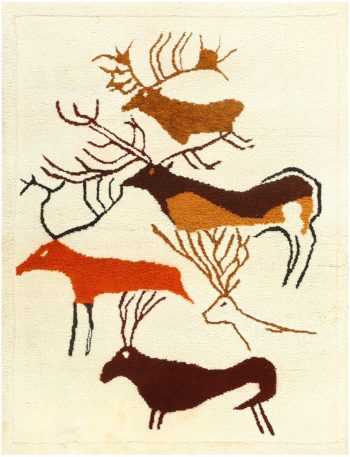Olga Fisch Rugs
View our current collection of vintage rugs and carpets by Olga Fisch below:
Vintage Olga Fisch Ecuadorian Rug 70385
$16,500.00Size: 6 ft 10 in x 10 ft 4 in (2.08 m x 3.15 m)Vintage Art Deco Ecuadorian Rug 48178 by Olga Fisch
$9,000.00Size: 5 ft x 6 ft 4 in (1.52 m x 1.93 m)
Learn More About Olga Fisch Rugs
View our entire collection of art rugs and carpets by famous artists
Olga Fisch Rugs – Olga Fisch nee Anhalzer (1901-1990) was an extraordinary artist, art dealer and cultural advocate. Born in Hungary, Olga Fisch traveled the world exploring the jungles of South America and living in Morocco where she assembled her first collection of cultural handicrafts. Although she traveled far and wide when boats, zeppelins and dangerous transport vehicles were the only ways to get around, she is deeply associated with Ecuador and the capital city of Quito where she lived and worked for most of her life.
In 1932, Olga married her second husband Bela Fisch. The couple emigrated from Europe due to political tensions in Nazi Germany that were particularly dangerous due to their Jewish heritage. By 1939, Fisch had traveled throughout the Mediterranean, South America and Africa. Finally, the couple settled in Ecuador after receiving an invite from a close friend. It was in Ecuador that Fisch, a former newspaper artist, began teaching at the School of Fine Arts. There she befriended students and teachers and made inroads into the artistic community. Fisch became deeply involved in Ecuadorian folk art. By 1943, Fisch’s collection of cultural artifacts and art attracted international attention. Lincoln Kirstein, the director of New York’s Museum of Modern Art, visited Ecuador to view the collection. This meeting catapulted Fisch into the spotlight and resulted in the U.N. and MoMA becoming her first clients.
During the 1950s, Fisch designed several successful area carpet lines, including the famous Caverna series. This particular line was inspired by the Lascaux cave paintings in France that were discovered in 1940. By the 1960’s, Fisch’s exclusive commission-based carpet business was a resounding success. She also started a non-profit museum dedicated to Ecuadorian cultural and a handicraft shop called Folklore that is still a cultural landmark in Quito. Fisch’s original style successfully adapted ancient Ecuadorian designs for a modern living environment. Even in her older years, Fisch was exceedingly clever and retained a keen sense of style that artfully combined archaeological inspiration and Pre-Colombian motifs with classical colonial influences.


